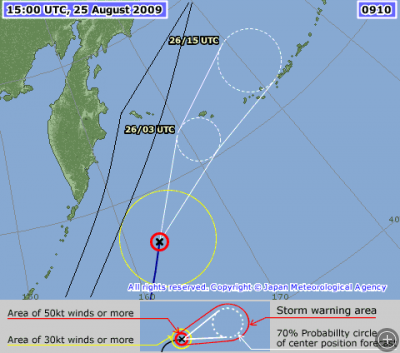Bad Weather and the JR
ABOARD THE JOIDES RESOLUTION, ON THE BERING SEA– If you aren’t familiar with our FaceBook page, you should sign up right now and become a fan of the JOIDES Resolution. One of our readers there posted a great question in response to my posts regarding the incoming Typhoon Vamco approaching us from the South. I consulted the Captain and he gave me a great response, so I posted it. In fact it was good enough to repost here. So here you go…
From our fan Robert J Palmer: “I have a quick question I hope its not rude, but what would be the maximum “swells” and “winds” that the JR would handle “safely” ? The drilling rig alarms me as a probable target to the wind.”
The extreme forces of nature in our vast oceans can be pretty daunting at times but if you consider a bottle with a good cork in it, the bottle will float forever unless damaged and water is allowed to enter. So, just like the bottle we must ensure that there is no water ingress in the JR by ensuring that the numerous weather tight doors and hatches are maintained in good condition and seal properly.
Next we must ensure that heavy equipment is properly secured and doesn’t move with the movement of the vessel as this could cause injury to personnel or damage to the watertight integrity of the vessel. We must ensure our propulsion and steering is in good shape because loss of control in a storm would cause the vessel to turn beam to the seas and roll very violently causing equipment to break loose and damage to occur.
To the drilling tower or derrick. Yes it is high and acts like a sail on a yacht heeling the vessel over to one side. But the JR was constructed to be able to withstand winds of 100 kts when intact or 70 kts when damaged with one compartment flooded.
Tropical Revolving Storms, also named Hurricanes, Typhoons or Tropical Cyclones depending on your location can exceed 150 kts at times and are extremely dangerous on the high seas. Fortunately for the modern mariner we have excellent tracking predictions and weather forecasting. Also the tropical storms are small and slow moving weather systems so they are generally easy to avoid.
The main problem with the JOIDES Resolution in heavy weather is our people are not hardened seafarers and there is a large amount of delicate scientific equipment which we do not wish to damage even slightly.
We can put figures on the vessels movement roll pitch & heave which we can safely “work in”. But to your quick question. What would be the maximum “swells” and “winds” that the JR would handle “safely”? She is a well built vessel and immensely strong, so let’s just say “with the very experienced crew we have on board, I am happy to sail to the ends of the Earth on her”.
Alex Simpson
Captain
JOIDES Resolution
*****
And so as to not cause unnecessary alarm, the Captain offered this weather update today as we make our way to Japan:
Vamco is moving slower than predicted. Although it is fast losing its status as a Typhoon, it is actually set to intensify again as a major North Pacific depression with associated storm force winds as it moves into the Bering Sea. We set out on our original course when we left the site early this morning. We have now adjusted our course towards Kamchatka to avoid the worst of the storm and should enjoy favorable weather for the next few days. There is no delay associated with this course change.

 No comments
No comments 






